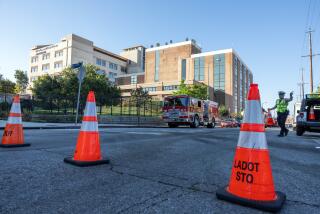Patient’s broken neck went unnoticed
Diane Rodrigues sang, prayed and bounced on her bed during the night at Metropolitan State Hospital. A nurse assigned to keep her under constant watch sat by, occasionally dozing.
By 7 a.m., the 52-year-old psychiatric patient was lying motionless on the floor, her neck broken.
It took at least an hour for caregivers at the Norwalk mental hospital to glean the extent of her injuries. It took four more hours to send her to a trauma center for treatment. Rodrigues, a former kindergarten teacher, was left paralyzed after the November 2009 accident and died six months later from related respiratory complications.
Internal investigative reports in the Rodrigues case, recently obtained by The Times, detail serious lapses in medical treatment at the height of a massive court-supervised effort to improve care in the state’s psychiatric hospitals. Among the findings: Staffers slept on the job, failed to conduct regular patient checks, moved Rodrigues despite what turned out to be a serious cervical injury, failed to summon timely help and lied to protect themselves and one another.
In the end, hospital investigators refused to sign the final draft because the recommendations were diluted by Metropolitan administrators, according to two sources familiar with the investigation who asked not to be identified because the process was confidential. Deleted from the report, for instance, was a proposal for mandatory staff training on head injuries. The factual findings were unaltered.
Rodrigues’ case was among about a dozen cited in court documents by a federal court monitor who faulted medical and psychiatric care at Metropolitan and Napa state hospitals as part of a petition to extend a U.S. Justice Department consent judgment governing the two facilities. A judge’s decision on the matter is pending. (Two other state hospitals have been released from court supervision.)
California Department of Mental Health officials have declined to discuss the Rodrigues case because it is the subject of ongoing litigation by her family. The department also denied a Times request for the results of the internal investigation into Rodrigues’ injury, which had been ordered by Metropolitan administrators.
But the newspaper was able to obtain the final report and five previous drafts, all of which found evidence of “gross negligence,” involving “incompetence, fraud, dishonesty, along with numerous policy and procedure violations.”
Rodrigues, who suffered from schizophrenia, had been placed at Metropolitan in September 2009 by a conservator to keep her from hurting herself or others. She cycled between periods of psychosis and quiet insight and had injured herself repeatedly — at one point gouging out her right eye with her fingers.
According to the report, Rodrigues was known to hurl herself to the floor. She had been given a low bed, and the walls and floor nearby were padded with exercise mats. Since admission, she had been put under constant one-on-one supervision. But on the night of the injury, the nurse assigned to her had to be awakened three times by the shift supervisor, investigators found.
Agitated and jumping on the bed, Rodrigues had received an antihistamine injection about 3:30 a.m. to calm her. Some time after 5:30 a.m., she propelled herself to the floor. Investigators found that staff members had been reluctant to physically stop her from leaping or tie her down with restraints.
According to their report, a psychiatric technician who was supposed to check on patients every half-hour did not do his job. Instead, he spent his time filling in for other staffers while each took an hourlong nap. The shift supervisor had instigated the practice and signed forms that falsely said the checks were done.
Cecilia Velasco, the registered nurse assigned to watch Rodrigues overnight, made no note of her fall and denied witnessing it. Afterward, according to investigators, Velasco “attempted to conceal Rodrigues’ injuries by placing a blue mat underneath her as she was lying on the floor.” When a co-worker arrived to relieve her, she told him Rodrigues had chosen to lie there.
Rodrigues complained of pain an hour later. A nurse lifted her by the shoulders to help her swallow Tylenol, then discovered a bleeding gash on her head. A vital-sign check revealed markedly low blood pressure. Rodrigues said she could not feel her legs. An examination of the pupil in her only functioning eye showed it was slow to respond to light — a sign of head injury.
A parade of staff members went in and out of Rodrigues’ room, yet communication was so poor that few seemed to know the extent of her injuries, and none summoned paramedics, according to the report
Dr. Paul Ananias, a psychiatrist, told investigators he had checked on Rodrigues at 8 a.m. to renew the order for constant supervision. He wrote in a chart note that Rodrigues told him, “I’m OK.” But Ananias could not identify any unit employee working that day, nor could he explain “why the staff members on duty at the time ... could not recall seeing him.”
A nurse serving as the day’s “health services specialist” told investigators she had paged the physician on duty, Dr. Tuyen Le, several times. But he did not arrive on the unit until about 10:30 a.m., the report notes.
Instead of summoning paramedics, Le called for a less expensive ambulance staffed by emergency medical technicians — resulting in a longer wait. “She’s paralyzed only, not life-threatening,” Le told hospital investigators in explaining his decision.
Asked “if he recognized a problem with Rodrigues lying on the floor paralyzed, absent medical treatment” for more than five hours, Le told investigators he believed that paramedics and even EMTs probably have more experience with head injuries than medical doctors do.
The Times was unable to reach Le, Velasco or Ananias for comment. Interviewed by investigators in the wake of the incident, Dr. Michael Barsom, then medical director and now interim head of the hospital, described Ananias as “one of his best psychiatrists.”
Experts say that treating patients within six hours after a spinal injury can be crucial to stemming damage.
The federal court monitor, Mohamed El Sabaawi, faulted the on-duty doctor in a December court declaration, saying the physician had “delayed treatment for several hours to a person who broke their spine.”
He noted that even before the incident he had told the hospital that this doctor — whom he did not identify by name — “was failing to provide people with minimally adequate care.” But the hospital, he said, “ignored my warnings.”
Of the dozen key staff members whose actions were faulted by investigators in the Rodrigues case, Le and another person retired and four — including Velasco — have resigned. The others still work at the hospital, including Ananias.
The investigators’ draft conclusions that seven employees violated state law against “any negligence, recklessness, or intentional act which results in the death of a patient” were stricken from later versions, along with nearly all their recommendations.
A parallel probe into possible criminal negligence was dropped, the sources familiar with the investigation said.
More to Read
Start your day right
Sign up for Essential California for news, features and recommendations from the L.A. Times and beyond in your inbox six days a week.
You may occasionally receive promotional content from the Los Angeles Times.







